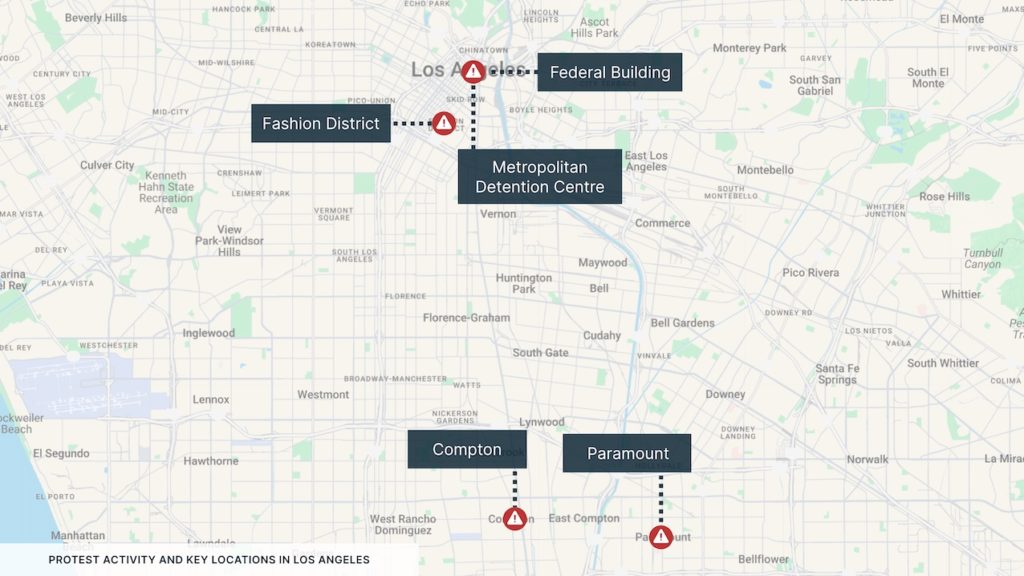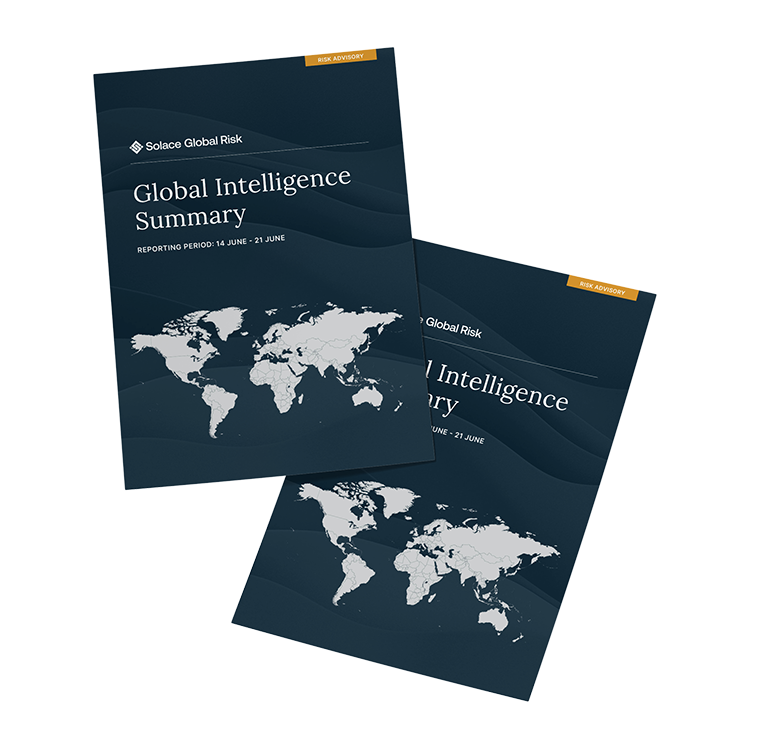Alert+
Evacuations from High-Risk Locations Call +44 (0)1202 308810 or Contact Us →
Anti-ICE Protests Intensify Across US Cities
Intelligence cut off: 12:30 BST 10 JUNE 2025
As of 10 June, demonstrations against the Immigration and Customs Enforcement (ICE) agency entered their fourth consecutive day in Los Angeles. The unrest began on 6 June, triggered by ICE raids in Los Angeles that resulted in the arrest of 118 people.
While Los Angeles has seen the most severe unrest so far, the protests have spread to multiple US cities, including Santa Ana, San Francisco, Austin, New York, Dallas, Houston, San Antonio, Chicago, Washington D.C., and Seattle.

In Los Angeles, the protests have seen the most violence in the Downtown area, which authorities have declared an “unlawful assembly” area. The unrest has resulted in vandalism, the erection of barricades, reports of looting, and the throwing of projectiles, including Molotov cocktails, at law enforcement. Furthermore, both local law enforcement and federal forces have deployed tear gas, rubber bullets, stun grenades, pepper spray and pepper balls, and used mounted units as part of crowd control operations.
The worst-impacted locations in Los Angeles include the area around the Metropolitan Detention Center, with demonstrators blocking the nearby Highway 101 and setting fire to Waymo driverless taxis; the Los Angeles Federal Building; the Fashion District; Paramount; and Compton.
On 7 June, US President Donald Trump ordered the deployment of 2,000 National Guard troops to the Los Angeles area, which has since been doubled to 4,000. 700 US Marines have been additionally activated for potential deployment; however, they are unable to directly participate in civilian policing unless the Insurrection Act is invoked, which the Trump administration has not done as of the time of writing.
The deployment of the National Guard and Marines has been met with staunch opposition by the Governor of California, Gavin Newsom, with the National Guard deployment being the first without a governor’s approval since 1965.
In the days following the initial outbreak of unrest in Los Angeles, “solidarity” protests broke out in multiple other US cities. Of these, the most significant protests took place in San Francisco, where close to 150 people were arrested following violent clashes near a downtown ICE office; Santa Ana, where tear gas and flashbangs were used against protesters outside the Santa Ana Federal Building; and New York, where 24 protesters were arrested at Trump Tower.
INTELLIGENCE ANALYSIS
White House Escalates Response to Unrest: Marines and National Guard Sent to Los Angeles
The civil unrest has been characterised by the relatively small size of demonstrations, compared to, for example, the Black Lives Matter protests. However, despite the low attendance, the level of disruption has been pronounced, highly likely due to a combination of both the propensity for the attendees to conduct direct action and due to the forceful response by authorities.
It is highly likely that protests will continue in the following days, given the so far established cycle of escalation. ICE raids were the initial primary trigger for the unrest, with the protests in Paramount, for example, being triggered by rumours of an ICE raid at a Home Depot. It is almost certain that further ICE raids will continue to act as a trigger for localised demonstrations in major US cities, with protesters attempting to stop the mass detentions through direct action.
As the protests progressed, however, additional triggers for escalation materialised. First, the arrest and hospitalisation of David Huerta, the President of the Service Employees International Union (SEIU), acted as a trigger for protests within the organised labour movement, with union chapters coordinating demonstrations.
Second, the deployment of the National Guard and then the proposed deployment of active-duty US Marines have catalysed so-called “solidarity” protests in other US cities.
A key trigger for further escalation would be the unlikely but possible scenario of the Trump administration invoking the Insurrection Act, which would allow the deployment of the armed forces for law-enforcement activities.
The most likely hotspots for demonstrations (and associated violent clashes with authorities) continue to be federal facilities, particularly ICE offices and federal detention centres, and areas where ICE raids are being conducted (with social media being a key means of enabling this).
There is a high risk of collateral violence to bystanders at these protests, given the levels of violence thus far, and they should be avoided as far as possible. Furthermore, the unrest has resulted in significant transport disruptions, with major freeway closures such as the 101 Freeway being closed in Los Angeles.
Travel Risk Advice: Safety Guidelines for Los Angeles, USA
- Avoid all protest areas in Los Angeles, particularly areas around the Metropolitan Detention Centre, the Fashion District, Compton, and Paramount.
- Closely monitor local news reports, government alerts, and the Solace Secure platform and trusted local media for updates relevant to the demonstrations.
- Follow the Los Angeles Police Department’s X page found here for the latest information regarding protest areas and associated traffic disruptions.
- Where possible, use alternative routes to steer clear of protest locations and avoid public transport.
- If in the vicinity of a protest, try to leave if it is safe to do so. Always abide by authority and police directions.
- If you are in a crowd and unable to leave, take precautions to minimise the risk of a crowd crush. These include staying upright, moving away from all hard barriers, going with and not against the crowd, and holding your arms at chest level in a boxer-like stance to relieve pressure.
- Ensure that you always carry personal identification documents or copies.
- Ensure knowledge of important contact numbers. These should include at least the local emergency number(s) and contacts for your local embassy or consulate.
- Expect a heightened security presence to continue beyond 10 June. This will likely result in protracted transport disruptions.

Intelligence Lite
Free
- Weekly Intelligence Email with Key Events
- Alert+ Situation Summary for Immediate Incidents
- Quarterly Global Election Report (Lite Version)
- Yearly Global Risk Outlook (Lite Version)
Intelligence Plus
Full Subscription
- Weekly Global Intelligence (Full Report)
- Alert+ Reports (Summary and Full Analysis)
- Quarterly Live Q&A Webinar with Intelligence Team
- Quarterly Global Election Report (Full Report)
- Yearly Global Risk Outlook
- Ongoing Thematic & Regional Deep Dive Reports
- On-demand Pre-Travel Advisories (2 reports per year)
Subscribe to receive full reports
Join the thousands of risk management professionals that rely on our intelligence every week.
Includes 70+ reports written by expert analysts.
Subscribe